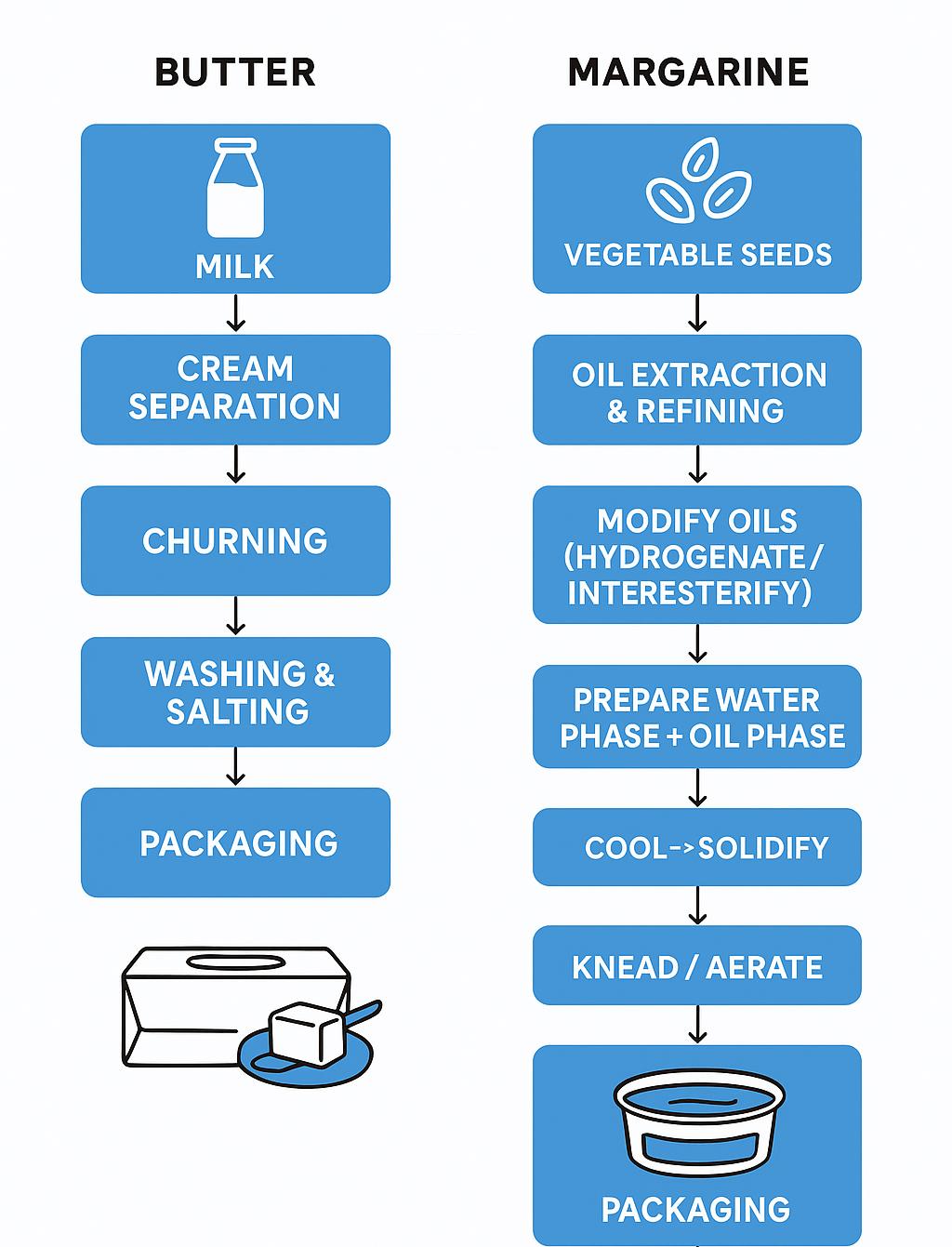Butter and margarine, both solidified emulsions of fats in water, may seem similar at first glance, but their production processes and historical trajectories are significantly more complex. Butter is derived from milk, while margarine is produced from vegetable oil. The science underlying these two spreads, however, extends beyond simple production methods.
The chemistry of butter production
Butter is primarily produced from milk, which is an emulsion of water, sugars, and microglobules of butterfat. The fats in butter are largely composed of triglycerides, which are long chains of fatty acids—each containing carboxylic acids—bonded in groups of three. While butterfat offers essential nutrients, it is also highly calorific. To address this, manufacturers often use centrifugation to separate the components of butter at high speed, removing a portion of the butterfat before the product is sold.
The process of transforming milk into butter involves breaking down the chemical forces that hold the butterfat in place. Each butterfat globule is encased in a lipoprotein membrane. By separating the fat and water in cream and then churning the mixture, producers physically disrupt this membrane, allowing the fat droplets to coalesce. The result is the familiar yellow butter, which is used in cooking, baking, or as a spread.

The origin and evolution of margarine
The origins of margarine are tied to a historical butter shortage in 19th-century France. In 1869, facing this shortage, Emperor Napoleon III sought an affordable substitute for butter to supply his military. He challenged chemists to create a replacement using beef fat, and the pharmacist Hippolyte Mège-Mouriès successfully produced oleomargarine by mixing beef tallow with skimmed milk. Although the product had a white colour that was unappealing to consumers, producers began dyeing it yellow to mimic the appearance of butter. Over time, vegetable oil replaced animal fat in the production process, especially during the early 20th century when butter was scarce due to the world wars. Margarine quickly gained popularity as a cheaper, more accessible alternative to butter.
Modern margarine production involves a more intricate chemical process than its earlier versions. Since vegetable oils are typically liquid at room temperature, manufacturers need to modify the fatty acids in their triglycerides to achieve a solid form. Fatty acids with a higher number of carbon–carbon double bonds generally have lower melting points. To solidify the oils, producers use hydrogenation, a process in which hydrogen gas is passed through the oil in the presence of a nickel catalyst. This reaction breaks some of the double bonds, saturating the fatty acid chains with hydrogen and increasing the melting point. However, this process creates a trade-off: while hydrogenation increases stability, it also raises the level of saturated fats, which are less healthy compared to unsaturated fats. Balancing the extent of hydrogenation is crucial for producing a spread that is both solid and relatively healthy.
The margarine controversy
Despite margarine’s rise to prominence, its acceptance has been fraught with controversy, particularly in the United States. Dairy farmers, fearing the competition posed by margarine, lobbied for legislative action to protect the butter industry. Beginning in 1877, states such as New York, New Hampshire, and Wisconsin passed laws prohibiting margarine from being dyed yellow to resemble butter. In some regions, margarine was even required to be dyed pink before it could be sold, making it visibly distinct from butter. These restrictions gave rise to an underground trade in yellow margarine, as consumers sought the spread despite the legal bans.
Scrutiny of butter and the rise of margarine
Butter, a longstanding staple , came under intense scrutiny when its high saturated fat content was linked to an increased risk of heart disease. Many people accepted this shift, reluctantly parting with butter’s rich flavour in favour of margarine, a change encouraged by researchers and nutritionists. However, this shift was not without consequence. It was later revealed that earlier margarines contained high levels of trans fats, which exacerbated heart disease risk by both raising LDL (bad cholesterol) levels and lowering HDL (good cholesterol) levels. This revelation left many feeling misled by health authorities.
The margarine vs. butter debate
The belief that margarine offered a heart-health advantage over butter was largely unfounded. There was never substantial evidence that switching from butter to margarine reduced the risk of heart disease or heart attacks. This shift was based on the assumption that margarine’s lower saturated fat content made it a healthier alternative, but it failed to account for the harmful effects of trans fats in older margarine formulations.
The modern assessment of butter and margarine
The current debate between butter and margarine is, in many respects, outdated. From a cardiovascular health standpoint, butter remains food to be consumed in moderation due to its high saturated fat content. However, margarine is no longer easily classified. While older stick margarines proved to be more detrimental than butter, newer formulations have emerged that contain lower levels of saturated fat, higher amounts of unsaturated fat, and no trans fats. These can be considered healthier alternatives, provided they are consumed in limited amounts due to their caloric density.
Nutritional information
Consumers can easily assess the health impact of various spreads, including butter and margarine, by examining nutrition labels. The U.S. Food and Drug Administration (FDA) now mandates that nutrition labels display both saturated fat and trans fat content. The recommended approach is to limit intake of saturated fats and to avoid trans fats entirely.
Healthier alternatives: Exploring olive oil and vegetable oil-based spreads
Healthier alternatives to butter or margarine are available, such as olive oil and spreads based on vegetable oils. These options are rich in mono- and polyunsaturated fats, which provide cardiovascular benefits. The next time you indulge in a warm piece of bread, consider dipping it in olive oil rather than spreading butter. For those aiming to reduce cholesterol levels, stanol-based spreads like Benecol and Take Control are preferable, as regular use of these products can help lower LDL cholesterol.
References
- Raising Levels Of. (2020) Butter vs. Margarine – Harvard Health. Retrieved September 29, 2024, from https://www.health.harvard.edu/staying-healthy/butter-vs-margarine
- Kit Chapman. (2023) Butter and margarine: what’s the difference? | Article | RSC Education. Retrieved September 29, 2024, from https://edu.rsc.org/everyday-chemistry/butter-and-margarine-whats-the-difference/4017116.article








